| |
These are the bagels |
|
 |
| |
 |
I make my own bagels at home. It's the only way to get them the way I like them: really brown and crusty on the outside, chewy on the inside, a nuanced yeasty flavor all the way through. I wouldn't say the process is difficult, but it is "involved." The effort to payoff ratio, however, is outstanding. You cannot buy these bagels anywhere. Do not tell me about your favorite bagel place in New York/New Jersey/Montreal/Bloomfield Hills. They do not make these bagels.
I've have made bagels many times. I've left things out, forgotten steps, and substituted ingredients. I have learned what is crucial, and what is merely best practices.
Crucial Ingredients
Malt Syrup
Used in the dough and in the boiling water. The crust will not be the same without it. I get it at Whole Foods.
High gluten flour
There are three ways to get this.
- Buy some "vital wheat gluten" from a health food store. Sift it into regular bread flour, 1 tsp per cup of flour (Did this a few times. Kind of a pain.)
- Go to a professional bakery and ask if you can buy some of their professional flour (Did this once. They weren't happy to accommodate me, but they did).
- Order "Sir Lancelot" flour from www.kingarthurflour.com. This is my preferred method. They do not sell Sir Lancelot in stores.
Crucial equipment
A baking stone and pizza peel.
Baking on a hot stone develops the crustiness. You need the pizza peel to get the bagels onto the stone because the oven will be seriously hot.
Natural baking parchment
The bagels have to be on parchment so you can slide them from the peel onto the stone. Some suggest using cornmeal for this purpose, but I find cornmeal on the bottom of my bagel unbearably yucky.
Crucial techniques
The cold rise
I actually don't know if this step is crucial, but I've never left it out. I start making bagels the night before I want to bake them. I make the dough, let it rise for an hour, shape it into bagels, then put the bagels in the fridge to rise overnight. This helps develop the yeasty flavor. It also breaks the whole process into two parts, making it less overwhelming.
The burst of steam
After I slide the bagels into the oven, I pour a little glass of 6 or 7 ice cubes into a cast iron pan on the bottom of the oven and close the door. This is common practice in baguette baking (not that I've ever done that) and does something good to the crust.
The Recipe
Makes 2 dozen bagels
(You can cut this in half to make one dozen, but if you're going to go to the trouble of making one dozen, why not make two?)
Ingredients
- 4 cups warm water
- 2 packets active dry yeast
- 4 tablespoons malt syrup
- 2 tablespoons salt
- 2 tablespoons vegetable oil
- 12 cups high gluten flour
- Oil for greasing bowl
- 1 tablespoon malt syrup for boiling water
- Toppings
| |
 |
|
- Put warm water in a large bowl and sprinkle yeast over the top. Add 4 tb malt syrup, erring on the low side (The syrup is thick. You don't have to get all the syrup off the spoon before filling it up again. Too much and the bagel gets a bit too malty-sweet. Let's say, between 3 and 4 tablespoons). Add 2 tablespoons salt and 2 tablespoons vegetable oil. Stir. Wait a minute or two, then make sure the yeast is moving around a bit. (Once I made the water too hot and killed the yeast. Another time I used expired yeast.)
- Mix in flour until dough is firm enough to take out of the bowl. Turn out onto floured surface and knead in the rest of the flour. As you add the last few cups of flour, the dough will get very stiff and dry. As you knead it and the gluten develops, it will get a bit sticky again, allowing you to add more flour. Get all the flour in and knead until you've got a stiff, smooth ball of dough.
- Very lightly grease two large bowls. Separate the dough into two equal parts (the stiffness of the dough should make this a little difficult), put each part into a bowl, cover, and put them in the oven (turned off) to rise for an hour or more. (I've forgotten about it for a few hours and nothing terrible happened)
 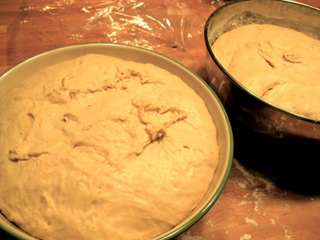
- Punch down dough. Take one bowl, tear dough in half, then halve each of those halves, then tear each of those halves into thirds (in other words "Make 12 equal balls of dough"). Form them into bagel shapes by poking your thumb through the middle of the dough ball and working your hand around (pictured). Lay them on wax paper in baking pans. Repeat with other bowl. Cover pans with plastic wrap and place in fridge overnight.
 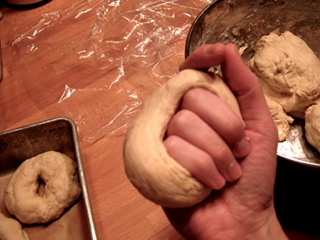

- In the morning, take the bagels out of the fridge and set a pot of water on the stove to boil (I use a 4 quart saucepan, but there's nothing magic about this). Put the pizza stone in the middle of the oven and place a cast iron pan on the bottom of the oven. Heat oven to 500. (Note that this recipe works just fine with a 60 year old oven)
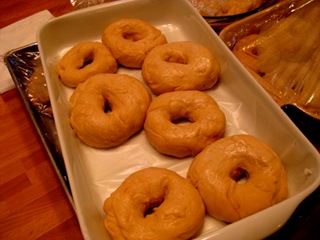 
- When the water is boiling, stir in one tablespoon of malt syrup. Drop in three bagels. Count 30 seconds, and flip them over with a slotted spoon. Wait another 30 seconds, then take them out and place them on a dishtowel. Do another three. Turn off the boiling water.

- Lay a piece of parchment on your pizza peel. Transfer the bagels from the towel to the peel and sprinkle on toppings to taste. (Don't use an egg wash or anything. Yuck). I use poppy seeds, white sesame seeds, coarse salt, and dried onions from www.penzeys.com. If you use the dried onions, soak them in a little water before putting them on. They won't get quite as blackened this way.

- Put 6 or 7 ice cubes in a cup. Open the oven. Slide the bagels-on-parchment onto the pizza stone, pour the ice into the pan on the bottom of the oven and shut the door. (If you also have a 60 year old oven, and the bagels seems to be taking forever to bake, check to see that the steam hasn't extinguished the pilot light. Only happened once.) Bake them until beautiful crusty brown. (20 minutes? I'm really not sure). Meanwhile, boil the water again and prepare the next half dozen.
- When the bagels are ready, carefully reach in and slide them onto a cookie sheet. (Sometimes I grab a strong piece of parchment with my oven mitt and get the whole thing out at once, but usually the scorched parchment tears and I sort of scoop everything onto the cookie sheet.) Put in the next batch. Boil the third batch, and so on.
- Wait for the bagels to cool a little. Then go for it. They are crusty on the outside. They are chewy on the inside. They are outstanding the first day. They are very good the second day. If there are any left after that, freeze them.
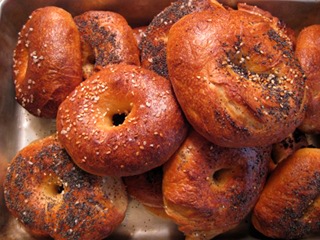 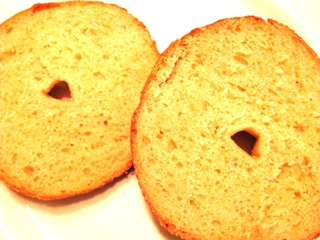 
|
 |
|